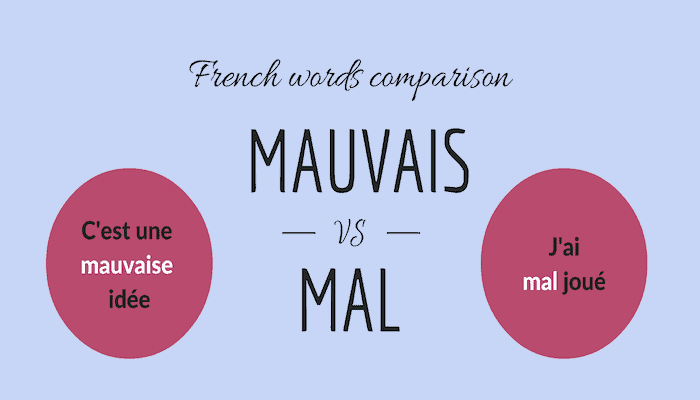How to use mauvais and mal ? Understanding Their Differences in French
Last updated date : 29th August 2024
Understanding how to use mauvais and mal in French can be quite challenging. While both relate to the idea of “bad,” their usage changes depending on the context. It is important to grasp these differences to improve your conversational skills in French.
As you dive into French, you will encounter various scenarios where choosing between mauvais and mal affects meaning. By exploring simple explanations and practical examples, you will gain the confidence needed to express yourself more clearly. This knowledge will help you navigate conversations, ensuring your choices reflect your understanding of good and evil, as well as how to appropriately describe different states and feelings.

1. Key Differences Between Mauvais and Mal
Firstly, to grasp the differences between mauvais and mal, let’s recognize their roles in sentences. Similarly to bon and bien, one is primarily an adjective while the other is more frequently an adverb.
- Mauvais is typically used as an adjective. This means it describes a noun and must agree in gender and number. It translates to “bad,” “mean,” or “wrong.” Here are some examples:
- C’est un mauvais gâteau = this is a bad cake
- C’est une mauvaise tarte = this is a bad tart
- Ce sont de mauvaises pâtisseries = these are a bad pastries
- Mal, on the other hand, is mainly an adverb. It does not change form and modifies a verb. You can understand it as “badly,” “poorly,” or “incorrectly.” There are instances when mal can also function as an adjective or a noun. For example:
- Les acteurs de ce film joue mal = Actors of this movie play poorly
- Elle s’habille mal = She doesn’t dress well. She’s wearing the wrong clothes.
Knowing when to use mauvais and mal will help you express ideas more accurately in French. And if you are still unsure about the differences between adjectives and adverbs, feel free to check the Thesaurus website.

2. When can we use mauvais ?
Now, the word mauvais is primarily an adjective but can also function as an adverb in some contexts. Here’s how you can use it effectively and avoid common mistakes in French :
2.1 Describing a Negative State
Use mauvais when you want to indicate that something is bad in quality, condition, or timing. For example:
- Elle est arrivée au mauvais moment translates to “She arrived at a bad time.”
- C’est une mauvaise viande means “This is bad meat.”
- Son ordinateur est en mauvais état means “His computer is in bad condition.”
2.2 Indicating Incorrectness
When referring to mistakes or incorrect choices, mauvais is suitable. For example:
- Désolé, vous avait fait le mauvais numéro = Sorry, you’ve dialled the wrong number
- Tu as commandé des chaussures à la mauvaise taille = You’ve ordered shoes at the wrong size.
2.3 Expressing a poor quality
This word is also used to describe low-quality art or health states. For instance:
- C’est une mauvaise pièce de théâtre = This is a poor play
- Tu es en mauvaise santé = Your health is poor
2.4 Describing Rough Conditions
You can also use mauvais for conditions like weather or sea states:
- La mer est mauvaise ce matin = The sea is rough this morning
In some cases, mauvais can act as an adverb, particularly with the verbs faire (to do or make) and sentir (to smell), as in:
- Il fait mauvais aujourd’hui means “The weather is bad today.”
- Ça sent vraiment mauvais ici translates to “It really smells bad here.”

3. Using 'mal' in Everyday Conversations
When you use mal, remember it commonly acts as an adverb. This translates to words like badly, poorly, or unwell. Here are some situations to consider:
3.1 Feeling Unwell
For example, you might say, “Paul va mal” to indicate Paul is feeling unwell.
3.2 Describing Poor Quality
You can express something is done improperly. A sentence like “Ton travail est vraiment mal fait” means your work is badly done.
Another example is “Cette porte ferme mal”, which shows that a door doesn’t close properly.
3.3 Saying You Did Something Poorly
You might say, “Hier j’ai mal mangé”, meaning you ate poorly yesterday.
Similarly, “Tu as mal dormi ?” questions if someone slept poorly.
Furthermore, mal can also serve as an adjective when combined with certain verbs, referring to something immoral or discomforting.
For instance, saying “C’est mal de mentir” indicates that lying is morally wrong. If you say “Je suis mal pour lui”, you express feeling uncomfortable for another person.
Lastly, mal functions as a noun to describe pain or evil.
An example is “Elle a le mal de mer”, which communicates that someone has seasickness. Another is “Juger le bien et le mal”, referencing the judgment of good and evil.

In summary, mauvais and mal are frequently mixed up. They both carry negative connotations and can function as adjectives, adverbs, or nouns. Yet, with some practice, you’ll quickly get the hang of this in your conversations. If you’re interested in learning the grammar, vocabulary, and subtleties of French in a more organic way, don’t hesitate to get in touch. It’s always a great time to begin your French learning journey. Wishing you the best and see you soon!



Comments are closed.